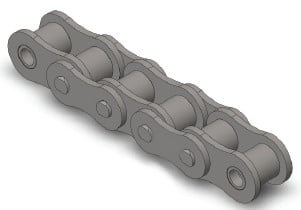Roller chains are a single from the most efficient and price eff ective methods to transmit mechanical power among shafts. They operate above a wide selection of speeds, take care of significant operating loads, have quite compact power losses and therefore are typically reasonably priced compared with other strategies
of transmitting power. Effective selection requires following numerous somewhat straightforward techniques involving algebraic calculation plus the utilization of horsepower and support aspect tables.
For any provided set of drive ailments, there are a variety of achievable chain/sprocket confi gurations that can effectively operate. The designer hence must be conscious of quite a few basic assortment rules that when applied appropriately, aid stability general drive performance and price. By following the ways outlined within this section designers needs to be in a position to produce selections that meet the necessities in the drive and therefore  are expense eff ective.
are expense eff ective.
Basic Roller Chain Drive Ideas
? The encouraged variety of teeth for your smaller sprocket is 15. The minimal is 9 teeth – smoother operation is obtained with far more teeth.
? The advisable optimum number of teeth to the significant sprocket is 120. Note that whilst a lot more teeth allows for smoother operation possessing too numerous teeth prospects to chain jumping off the sprocket soon after a comparatively tiny level of chain elongation resulting from wear – That is certainly chains with a very large quantity of teeth accommodate less put on before the chain will no longer wrap around them correctly.
? Speed ratios needs to be 7:one or less (optimum) and never better
than 10:1. For more substantial ratios the usage of many chain reductions is advised.
? The encouraged minimal wrap on the tiny sprocket is 120°.
? The advisable center distance between shafts is 30-50 pitches of chain. You’ll find two exceptions to this as follows:
1. The center distance need to be better compared to the sum on the outside diameters in the driver and driven sprockets to prevent interference.
two. For pace ratios better than 3:one the center distance shouldn’t be significantly less than the outdoors diameter of your massive sprocket minus the outside diameter of your little sprocket to assure a minimum 120° wrap all over the tiny sprocket.